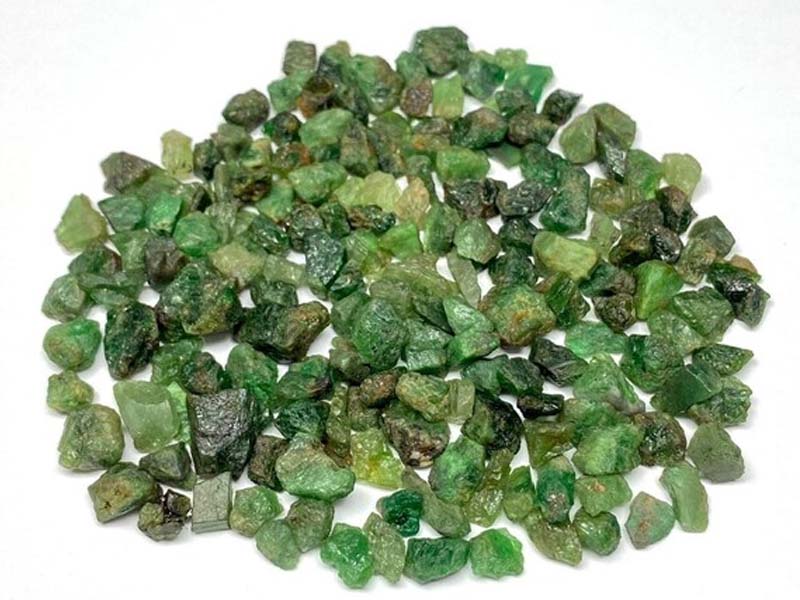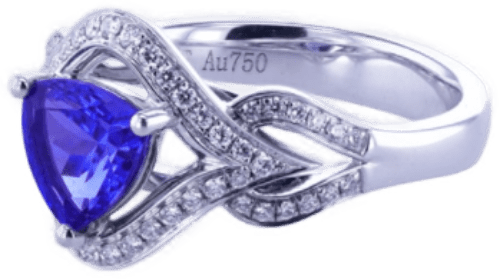Werfen Sie einen Blick auf unser Neu eingetroffen: eine Vielzahl von Auswahlmöglichkeiten jetzt verfügbar!
What distinguishes tsavorites from other gemstones? Discover the vibrant, deep green tsavorite - a member of the garnet kin family heralded for its natural rarity and brilliance. Unlike emeralds, Vibrant Green Gem are not only scarcer but also unavailable in synthetic forms, making them a unique treasure in the gem world. Learn about their origins, properties, and the compelling reasons behind their valued place in jewelry.
Tsavorites are an epitome of nature’s artistry, possessing a mesmerizing green hue that rivals even the finest emeralds. These precious gems are part of the garnet kin, but their scarcity sets them apart as the world’s finest verdant garnets. They surpass emeralds in rarity, being approximately 200 times less common, and there are no synthetically produced versions on the market.
Some key facts about Tsavorites:
These facts highlight the high esteem in which these gems, often found in small deposits, are held.
Their rarity isn’t the only factor contributing to their desirability. Tsavorites are coveted by gem collectors and jewelry enthusiasts for their vibrant verdant colors and exceptional brilliance, attributes that owe to a high index of refraction and dispersion levels. Despite being cut similarly to other gems, their unique color and rarity have increased their appeal among those who value natural beauty in gemstones.

The intriguing story of tsavorites dates back to 1967 when they were first discovered by Scottish geologist Campbell Bridges in northern Tanzania. This discovery marked the first sighting of these mesmerizing gems. However, after the nationalization of this Tanzanian mine, Bridges moved to Kenya and discovered more deposits of this green garnet by the end of 1970.
The gemstone was named ‘tsavorite’ to honor its Kenyan origin, specifically the nearby Tsavo National Park. The ‘ite’ ending was added to the name ‘Tsavo’ in line with modern mineralogical nomenclature. After some deliberation, Tiffany & Co. settled on the trade name ‘Tsavorite’, rejecting the German proposal of ‘Tsavolite’.
The International Confederation of Jewellery, Silverware, Diamonds, Pearls, and Stones, CIBJO, accepted this name for the green or verdant precious stone variety of garnet, as recognized by the International Gem Society in the jewelry industry.
The current popularity and attractiveness of tsavorites in the gemstone market is a testament to the successful marketing campaign by Tiffany & Co. in the 1970s. Henry B. Platt, the President of Tiffany & Co. during that time, played an influential role in the branding of tsavorite, including its naming. The gemstones were featured in Tiffany & Co.’s Blue Book collection, emphasizing their vivid green color and exotic allure, further cementing their desirability in the market.
The garnet kin boasts a vibrant array of gem types and colors, encompassing hues of:
Among the twenty garnet species, only five are commercially significant as gems: pyrope, almandine, spessartine, grossular, and andradite. Tsavorite garnet is a rare type of grossular garnet known for its range of greens from light to deep grass verdant, not found in other garnet types. This unique color range, along with their exceptional brilliance, positions Kenyan Gemstone as one of the most prized gems in the garnet kin.
While green garnets share a similar crystal structure with other silicate minerals, they differ significantly in their chemical makeup. Their green color is primarily due to the presence of vanadium, with higher levels resulting in a more intense and darker verdant. Unlike many gems, green silicate minerals have not been successfully synthesized, owing to their complex chemical and physical properties. This inability to create man-made versions of tsavorite further enhances their allure and scarcity, making tsavorite crystals highly sought after.
Tsavorites possess distinct properties that greatly enhance their overall allure. They typically have a specific gravity that ranges from 3.60 to 3.68, which impacts their weight compared to other gems of equivalent size.
When viewed from different angles, green garnets can exhibit weak to moderate pleochroism, displaying various shades of verdant that add depth to their radiance.
Tsavorite garnets are well-known for their hardness, with a rating of 7 to 7.5 on the Mohs scale. This hardness makes them generally durable for daily wear. However, they should not be exposed to sudden temperature changes as it could lead to damage.
When it comes to cleaning, an ultrasonic cleaner is usually safe unless the gem has preexisting cracks or fractures.
The brilliance and sparkle of tsavorite garnets can largely be attributed to their high index of refraction. They exhibit an index of refraction ranging from 1.740 to 1.773 and are singly refractive, displaying the same refractive index in all directions. In addition to a high index of refraction, tsavorites also exhibit a moderate dispersion value of 0.028, contributing to their fire. The combination of these properties enhances the gemstone’s overall brilliance and visual appeal.
Tsavorite is a calcium aluminum silicate with the chemical formula Ca3Al2(SiO4)3. Its green color is primarily due to the presence of vanadium, with higher levels of vanadium leading to a more intense and darker green.
This unique chemical composition gives green garnets their signature deep green color, making them a standout gem in the garnet kin.
Tsavorite is the most expensive garnet available on the market, particularly when considering stones that exhibit top color, fine quality, and clean grades in sizes over two carats. The value of tsavorites is determined by the 4C’s:
These factors are assessed using well-established grading systems, ensuring accurate and consistent valuation.
Color plays a significant role in the valuation of tsavorites. The most prized stones exhibit a rich, vivid green hue, and top color grades are typically associated with the finest stones. The value of a tsavorite increases when its color resembles that of an emerald, without darkening or displaying yellowish tints.
Lower grade green silicate minerals either display low saturation, resulting in a washed-out appearance, or suffer from over-saturation and high tone levels that make them appear too dark.
Clarity is another crucial factor in tsavorite valuation. Tsavorite is classified as a Type II gemstone by the GIA, meaning it is usually included to some degree. Despite this, green silicate minerals are generally known for their cleaner appearance compared to other gems, often found with minimal inclusions.
Visible imperfections on the crown are more detrimental than those on the pavilion, and transparent stones show color richness as well as any present imperfections clearly.
Tsavorites are usually found in small sizes; those exceeding 2.5 carats are exceedingly rare and thus command higher value. Prices escalate considerably with carat weight, highlighting the scarcity and demand for larger stones. In comparison, a one carat tsavorite is more common but still holds significant value. When it comes to cut, the most favored cuts for tsavorites are:
These cuts showcase the beauty of the tsavorite precious stone, especially when the carat jumps dramatically, making it a perfect choice for a rare gem company.
A well-proportioned cut is critical to avoid unnecessary excess weight and enhance the gemstone’s overall appeal.
The striking attractiveness and rareness of tsavorites have fueled their growing demand in jewelry-making. From engagement hoops and earrings to pendants, green garnets are being incorporated into a wide variety of jewelry designs. Vintage-inspired tsavorite engagement rings incorporate intricate details such as filigree or milgrain edging, evoking a sense of timeless elegance. For a modern aesthetic, tsavorite engagement circlets also come in minimalist styles that focus on clean lines and simplicity.
Large, oval tsavorite gems are frequently set in unique ring designs, flanked by diamonds to accentuate the central stone’s attractiveness. Pendants featuring a prominent tsavorite of around 5 carats, often paired with diamonds, make for striking and popular jewelry choices. Whether you prefer a classic or contemporary style, tsavorite precious stone jewelry can be crafted to be one-of-a-kind, fully showcasing the exceptional qualities of the gemstone in unique custom designs.
Regular and basic care is pivotal to maintaining the pristine condition of your tsavorite gem jewelry. Start by cleaning your tsavorite with a mixture of mild dish soap and warm water. Use a soft brush, such as a baby toothbrush, to gently scrub the gemstone and remove impurities around the stone.
For a more thorough cleaning, soak your tsavorite jewelry in the soapy water solution for several hours. After soaking, rinse the tsavorite with clean water to remove any soapy residue. With these simple steps, you can ensure that your tsavorite gemstones retain their brilliance and beauty.
With an enchanting green hue, exceptional brilliance, and remarkable rarity, tsavorites stand out as a unique gem in the garnet kinfolk family. Their captivating history, stunning properties, and the role they play in the world of jewelry make them a gem collector’s delight and a jewelry enthusiast’s dream. Whether you’re admiring a tsavorite from afar or wearing one close to your heart, you’re not just appreciating a gemstone; you’re cherishing a piece of Earth’s history.
The rarest green or verdant gemstone is Tsavorite, which ranges in color from olive to evergreen and is one of the rarest precious stones in the world.
Yes, tsavorite is a good investment due to its rich green color, affordability compared to emeralds, and significant increase in valuation over the past decade.
Yes, despite being rarer than emeralds, tsavorite is surprisingly more affordable, making it an appealing choice for those seeking a unique, high-quality gemstone at a lower price.
Yes, tsavorites can range in value from a few dollars per carat to as high as $8000 per carat, depending on their quality. May 26, 2023.
It is relatively hard to find large Tsavorite crystals of gem quality (Facetable grade) hence making it one among the rare coloured gemstones.
